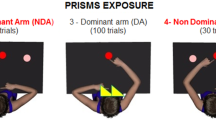Abstract
Previous findings show an advantage in response speed when stimulus and response correspond spatially (i.e., the Simon effect). Chronic unilateral amputees show altered spatial perception near their affected hand, providing an opportunity to investigate whether experience also affects the visuomotor stimulus–response (S–R) mapping that underlies the Simon effect. We used a two-alternative, forced-choice paradigm to probe the spatial correspondence between visual cues and responses, in 14 unilateral upper limb amputees and 14 matched controls. We presented visual stimuli in 5 different locations within peripersonal space, including the midline, and found a smooth gradient of S–R correspondence effects. This is consistent with the hypothesis that S–R correspondence is represented along a spatial gradient. Unilateral amputees performed indistinguishably from matched controls, regardless of whether stimuli appeared in the hemispace ipsi- or contralateral to their missing limbs. This is inconsistent with the hypothesis that experience-dependent visual distortions entail changes in the S–R mapping; alternatively, it could reflect a complete experience independence of the Simon effect. We propose that the affordance competition hypothesis (Cisek in Philos Trans R Soc B Biol Sci 362:1585–1599, 2007) explains the Simon effect and the underlying gradient of S–R correspondence.




Similar content being viewed by others
References
Anzola GP, Bertoloni G, Buchtel HA, Rizzolatti G (1977) Spatial compatibility and anatomical factors in simple and choice reaction time. Neuropsychologia 15:295–302
Cisek P (2007) Cortical mechanisms of action selection: the affordance competition hypothesis. Philos Trans R Soc B Biol Sci 362:1585–1599. doi:10.1098/rstb.2007.2054
Cisek P, Kalaska JF (2005) Neural correlates of reaching decisions in dorsal premotor cortex: specification of multiple direction choices and final selection of action. Neuron 45:801–814. doi:10.1016/j.neuron.2005.01.027
Cisek P, Kalaska JF (2010) Neural mechanisms for interacting with a world full of action choices. Annu Rev Neurosci 33:269–298. doi:10.1146/annurev.neuro.051508.135409
De Jong R, Liang CC, Lauber E (1994) Conditional and unconditional automaticity: a dual-process model of effects of spatial stimulus-response correspondence. J Exp Psychol Hum Percept Perform 20:731–750
Fagioli S, Hommel B, Schubotz RI (2007) Intentional control of attention: action planning primes action-related stimulus dimensions. Psychol Res 71:22–29. doi:10.1007/s00426-005-0033-3
Gibson J (1979) The ecological approach to visual perception. Houghton-Mifflin, Boson
Hommel B (2009) Action control according to TEC (theory of event coding). Psychol Res 73:512–526. doi:10.1007/s00426-009-0234-2
Hommel B (2011) The Simon effect as tool and heuristic. Acta Psychol (Amst) 136:189–202. doi:10.1016/j.actpsy.2010.04.011
Hommel B, Muesseler J, Aschersleben G, Prinz W (2001) The Theory of Event Coding (TEC): a framework for perception and action planning. Behav Brain Sci 24:849–937
Klein RM, Ivanoff J (2010) The components of visual attention and the ubiquitous Simon effect. Acta Psychol (Amst) 1–10. doi:10.1016/j.actpsy.2010.08.003
Lotze M, Grodd W, Birbaumer N, Erb M, Huse E, Flor H (1999) Does use of a myoelectric prosthesis prevent cortical reorganization and phantom limb pain? Nat Neurosci 2:501–502
Makin TR, Wilf M, Schwartz I, Zohary E (2010) Amputees “Neglect” the space near their missing hand. Psychol Sci 21:55–57. doi:10.1177/0956797609354739
McKinstry C, Dale R, Spivey MJ (2008) Action dynamics reveal parallel competition in decision making. Psychol Sci 19:22–24. doi:10.1111/j.1467-9280.2008.02041.x
Metzker M, Dreisbach G (2009) Bidirectional priming processes in the Simon task. J Exp Psychol Hum Percept Perform 35:1770–1783. doi:10.1037/a0015787
Mewaldt SP, Connelly CL, Simon R (1980) Response selection in choice reaction time: test of a buffer model. Mem Cognit 8:606–611
Nico D, Daprati E, Rigal F, Parsons L, Sirigu A (2004) Left and right hand recognition in upper limb amputees. Brain 127:120–132
Nicoletti R, Umilta C (1989) Splitting visual space with attention. J Exp Psychol Hum Percept Perform 15:164–169
Nicoletti R, Umilta C (1994) Attention shifts produce spatial stimulus codes. Psychol Res 56:144–150
Nicoletti R, Anzola GP, Luppino G, Rizzolatti G, Umilta C (1982) Spatial compatibility effects on the same side of the body midline. J Exp Psychol Hum Percept Perform 8:664–673
Oldfield R (1971) The assessment and analysis of handedness: the Edinburgh inventory. Neuropsychologia 9:97–113
Philip BA, Frey SH (2011) Preserved grip selection planning in chronic unilateral upper extremity amputees. Experimental brain research. Experimentelle Hirnforschung Expérimentation cérébrale 214:437–452. doi:10.1007/s00221-011-2842-5
Rabbitt P (1978) Hand dominance, attention, and the choice between responses. Q J Exp Psychol 30:407–416
Reilly KT, Mercier C, Schieber MH, Sirigu A (2006) Persistent hand motor commands in the amputees’ brain. Brain 129:2211–2223. doi:10.1093/brain/awl154
Rizzolatti G, Riggio L, Dascola I, Umilta C (1987) Reorienting attention across the horizontal and vertical meridians: evidence in favor of a premotor theory of attention. Neuropsychologia 25:31–40
Rubichi S, Nicoletti R, Iani C, Umiltà C (1997) The Simon effect occurs relative to the direction of an attention shift. J Exp Psychol Hum Percept Perform 23:1353–1364
Simon JR, Berbaum K (1990) Effect of conflicting cues on information processing: the ‘Stroop effect’ vs. the ‘Simon effect’. Acta Psychol (Amst) 73:159–170
Simon JR, Rudell AP (1967) Auditory S-R compatibility: the effect of an irrelevant cue on information processing. J Appl Psychol 51:300–304
Simon JR, Small AM (1969) Processing auditory information: interference from an irrelevant cue. J Appl Psychol 53:433–435
Song J-H, Nakayama K (2009) Hidden cognitive states revealed in choice reaching tasks. Trends Cognit Sci 13:360–366. doi:10.1016/j.tics.2009.04.009
Valle-Inclán F, Redondo M (1998) On the automaticity of ipsilateral response activation in the Simon effect. Psychophysiology 35:366–371
Wallace RJ (1971) S-R compatibility and the idea of a response code. J Exp Psychol 88:354–360
Wascher E, Schatz U, Kuder T, Verleger R (2001) Validity and boundary conditions of automatic response activation in the Simon task. J Exp Psychol Hum Percept Perform 27:731–751
Acknowledgments
This work was supported by grant #W81XWH-09-2-0114 to S.H.F. from the United States Army Medical Research Acquisition Activity. The authors thank Manja Metzker for her initial help understanding the Simon effect.
Conflict of interest
The authors declare that they have no conflict of interests.
Author information
Authors and Affiliations
Corresponding author
Rights and permissions
About this article
Cite this article
Philip, B.A., Frey, S.H. Stimulus–response correspondence across peripersonal space is unaffected by chronic unilateral limb loss. Exp Brain Res 224, 373–382 (2013). https://doi.org/10.1007/s00221-012-3317-z
Received:
Accepted:
Published:
Issue Date:
DOI: https://doi.org/10.1007/s00221-012-3317-z




